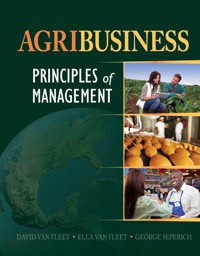When Howard Schultz bought the company in 1987, it was a small Seattle coffee bean retailer. It
Question:
When Howard Schultz bought the company in 1987, it was a small Seattle coffee bean retailer. It has since grown to nearly 18,000 stores in 60 countries. Not satisfied to be the largest and most recognized coffee purveyor in the world, Starbucks is also positioning itself as a leader in quality broadly defined to include corporate social responsibility. It wants to demonstrate that it is possible to grow, be profitable, have high quality products, and be responsible. Or at least these are the goals set by Mr. Schultz. As Kermit the Frog™, put it so well in song, “It’s not easy being green.” This was especially true between 2008–2010 when an unfavorable economic environment forced store closings, corporate restructuring, and acknowledging stronger competition from McDonald’s and Dunkin’ Donuts. However, Schultz has retained the corporate quality and responsibility agenda regardless of economic circumstances. Starbucks’ basic product—coffee—is not a given. Its coffee purchases account for 3 percent of total global Arabica coffee bean supplies, but it is not the world’s largest coffee buyer. Coffee prices in 2010 hit historical levels because of grower problems. This meant coffee purveyors raised prices or took a margin hit. Initially, Starbucks chose the margin hit; McDonald’s raised prices; later Starbucks relented and changed some prices, too.
The coffee world has grown complicated. Brazil added to coffee grower problems by demanding inclusion on the Intercontinental Exchange (ICE). It wants to join the 19 other Arabica bean growers on the exchange. Until 2010, Brazil was content to be an outsider, but its inclusion on ICE’s futures exchange means its bean would be included on all “C” futures contracts. Nestlé, a Starbucks’ competitor on the grocery shelf, is initiating a $487 million cultivation project in Mexico. It will train thousands of Mexican farmers to grow new coffee trees over the next ten years. “We shouldn’t just be the world’s biggest coffee buyer, we should be involved upstream,” said Nestlé’s CEO Paul Bulcke. Vertical integration will affect the competitive environment on the grocery store coffee shelf—a place where Starbucks (through an agreement with Kraft Foods) and Nestlé compete. These situations would be complicated and involved anyway, but the problems are compounded by Howard Schultz’s demand that Starbucks be 100 percent fair-traded and Coffee and Farmer Equity certified by 2015.
Then there are problems with the company-owned stores. Not only are the customer lines longer than in the past, many consumers are feeling that quality is slipping since Starbucks began its move to make the stores operate more efficiently. Coffee making was becoming a mechanized process with all the romance of an assembly line. The perception of customers may not be far from the truth. For the past few years Starbucks has been applying the “lean manufacturing techniques car makers have long used.” At least lean rhymes with green.
Finally, there is “the cup.” Introduced in 1984, the Starbucks logo cup has become a cultural icon. It is also a monumental problem. Approximately three billion of the nation’s 200-plus billion paper cups in municipal trash dumps have the Starbucks logo. “From the customer’s standpoint, the cup is our No.1
environmental liability,” says Jim Hanna, Starbucks’ Director of Environmental Impact. Mr. Hanna is feeling because Howard Schultz pledged that Starbucks would have 100 percent recyclable cups by 2012. Starbucks is working with its competitors Tim Hortons, Dunkin’ Donuts, McDonald’s, and Green Mountain to solve this monumental problem.
The cup problem in a nutshell is that Starbucks has no control over where its customers put their cups. It is not a problem of waste disposal or recycling; it calls for cultural change. That cultural change is expected to result in the customer being provided an incentive or otherwise induced either
(a) To dispose of the cup appropriately
(b) To bring a personal re-usable cup with them to the store. Culture change is not easy, and the goal is 2012.......
QUESTIONS
1. Is “being green” realistically a part of quality for organizations? Did Starbucks reach its recyclability goal for 2012?
2. How are quality and productivity related at Starbucks?
3. What strategic and operational approaches to quality and responsibility are being used by Starbucks?
Step by Step Answer:

Agribusiness Principles Of Management
ISBN: 9781285952352,9781285947839
1st Edition
Authors: David Van Fleet, Ella Van Fleet, George J. Seperich





